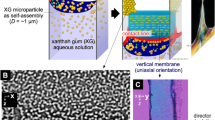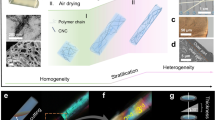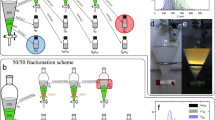Abstract
Drying-induced patterns, “meniscus splitting”, are introduced through a series of experiments using self-assembled polysaccharides. When physicochemical factors such as the geometry of the evaporative air–liquid interface are controlled, the depositing polymer bridges the gap between two substrates to create multiple nuclei at specific positions for membrane growth. These phenomena were first discovered by our group based on viscous fingering, known as tears of wine. By developing interfacial instability, meniscus splitting causes partitioning of a space by membranes, similar to dissipative structures seen in nature, “from one space into multiple spaces.” In the field of advanced biomimetic materials, the method of convective meniscus splitting would be useful for devising a powerful strategy for the preparation of hierarchically self-assembled materials from a variety of polymeric materials.
This is a preview of subscription content, access via your institution
Access options
Subscribe to this journal
Receive 12 print issues and online access
$259.00 per year
only $21.58 per issue
Buy this article
- Purchase on Springer Link
- Instant access to full article PDF
Prices may be subject to local taxes which are calculated during checkout








Similar content being viewed by others
References
Henisch HK. Crystals in gels and Liesegang rings. Cambridge University Press; New York 1988.
Turing AM. The chemical basis of morphogenesis. Philos Trans R Soc B. 1952;237:37–72.
Kondo S, Miura T. Reaction-diffusion model as a framework for understanding biological pattern formation. Science. 2010;329:1616–20.
Cazabat AM, Heslot F, Trolan SM, Carles P. Fingering instability of thin spreading films driven by temperature gradients. Nature. 1990;346:824–6.
Brzoska JB, Brochard-Wyard F, Rondelez F. Exponential growth of fingering instabilities of spreading films under horizontal thermal gradients. Europhys Lett. 1992;19:97–102.
Lajeunesse E, Martin J, Rakotomalala N, Salin D. 3D Instability of miscible displacements in a Hele–Shaw cell. Phys Rev Lett. 1997;79:5254–7.
Lindner A, Coussot P, Bonn D. Viscous fingering in a yield stress fluid. Phys Rev Lett. 2000;85:314–7.
Maillard M, Motte L, Pileni MP. Ring and hexagons made of nanocrystals. Adv Mater. 2001;13:200–4.
de Gennes PG, Brochard-Wyart F, Quéré D. Capillarity and wetting phenomena: drops, bubbles, pearls, waves. Springer; New York 2003.
Rabbani HS, Or D, Liu CY, Lai C, Lu NB, Datta SS, et al. Suppressing viscous fingering in structured porous media. Proc Natl Acad Sci USA. 2018;115:4833–8.
Osada Y, Okuzaki H, Hori H. A polymer gel with electrically driven motility. Nature. 1992;355:242–4.
Osada Y, Gong JP. Soft and wet materials: polymer gels. Adv Mater. 1998;10:827–37.
Weissman JM, Sunkara HB, Tse AS, Asher AS. Thermally switchable periodicities and diffraction from mesoscopically ordered materials. Science. 1996;274:959–60.
Yoshida R, Takahashi T, Yamaguchi T, Ichijo H. Self-oscillating gel. J Am Chem Soc. 1996;118:5134–5.
Kato T. Self-assembly of phase-segregated liquid crystal structures. Science. 2002;295:2414–8.
Yoshida R. Self-oscillating gels driven by the Belousov–Zhabotinsky reaction as novel smart materials. Adv Mater. 2010;22:3463–83.
Okuzaki H, Kuwabara T, Funasaka K, Saido T. Humidity-sensitive polypyrrole films for electro-active polymer actuators. Adv Funct Mater. 2013;23:4400.
Ilievski F, Mazzeo AD, Shepherd RF, Chen X, Whitesides GM. Soft robotics for chemist. Angew Chem Int Ed. 2011;50:1–7.
Yang D, Mosadegh A, Lee B, Khashai F, Suo Z, Bertoldi K, et al. Buckling of elastomeric beams enables actuation of soft machines. Adv Mater. 2015;27:6323–7.
Okeyoshi K, Yoshida R. Hydrogen generating gel systems induced by visible light. Soft Matter. 2009;5:4118–23.
Okeyoshi K, Yoshida R. Temperature control of photoreaction for hydrogen generating gel systems. Chem Commun. 2009;6400–2.
Okeyoshi K, Yoshida R. Oxygen-generating gel systems induced by visible light. Adv Funct Mater. 2010;20:708–14.
Okeyoshi K, Yoshida R. Role of copolymerized photosensitizer in hydrogen-generating gel systems for higher quantum efficiency. Chem Commun. 2011;49:4935–7.
Okeyoshi K, Suzuki D, Kishimura A, Yoshida R. Photoinduced hydrogen-generating nanogel systems. Small. 2011;7:311–5.
Okeyoshi K, Yoshida R. Effect of microtubule polymerization on photoinduced hydrogen generation. Chem Commun. 2015;51:11607–10.
Okeyoshi K, Yoshida R. Polymeric design for electron transfer in photoinduced hydrogen generation through a coil-globule transition. Angew Chem Int Ed. 2019;58:7304–7.
Okeyoshi K, Kawamura R, Yoshida R, Osada Y. Thermo- and photo-enhanced microtubule formation from Ru(bpy)32+-conjugated tubulin. J Mater Chem B. 2014;2:41–5.
Okeyoshi K, Kawamura R, Yoshida R, Osada Y. Effect of microtubules polymerization on photoinduced hydrogen generation. Chem Commun. 2015;51:11607–10.
Okeyoshi K, Kawamura R, Yoshida R, Osada Y. Microtubule teardrop patterns. Sci Rep. 2015;5:9581.
Mitsunaga R, Okeyoshi K, Yoshida R. Design of a comb-type self-oscillating gel. Chem Commun. 2013;49:4935–7.
Pokroy B, Kang SH, Mahadevan L, Aizenberg J. Self-organization of a mesoscale bristle into ordered hierarchical helical assemblies. Science. 2009;323:237–40.
Noorduin WL, Grinthal A, Mahadevan L, Aizenberg J. Rational designed complex, hierarchical microarchitectures. Science. 2013;340:832–7.
Vogel N, Utech S, England G, Shirman T, Phillips KR, Koay N, et al. Color from hierarchy: Diverse optical properties of micron-sized spherical colloidal assemblies. Proc Natl Acad Sci USA. 2015;112:10845–50.
Cai Y, Newby BZ. Marangoni flow-induced self-assembly of hexagonal and stripelike nanoparticle patterns. J Am Chem Soc. 2008;130:6076–7.
Deegan RD, Bakajin O, Dupont TF, Huber G, Nagel SR, Witten TA. Capillary flow as the cause of ring stains from dried liquid drops. Nature. 1997;389:827–9.
Saffman PG, Taylor G. The Penetration of a fluid into a medium or Hele-Shaw cell containing a more viscous liquid. Proc Ro Soc Lond A. 1958;245:312–29.
Okeyoshi K, Okajima MK, Kaneko T. Milliscale self-Integration of megamolecule biopolymers on a drying gas-aqueous liquid crystalline interface. Biomacromolecules. 2016;17:2096–103.
Okeyoshi K, Okajima MK, Kaneko T. Emergence of polysaccharide membrane walls through macro-space partitioning via interfacial instability. Sci Rep. 2017;7:5615.
Okeyoshi K, Joshi G, Okajima MK, Kaneko T. Formation of polysaccharide membranes by splitting of evaporative air–LC interface. Adv Mater Inter. 2018;5:1701219.
Okeyoshi K, Shinhama T, Budpud K, Joshi G, Okajima MK, Kaneko T. Micelle-mediated self-assembly of microfibers bridging millimeter-scale gap to form three-dimensional-ordered polysaccharide membranes. Langmuir. 2018;34:13965–70.
Okeyoshi K, Yamashita M, Sakaguchi T, Budpud K, Joshi G, Kaneko T. Effect of evaporation rate on meniscus splitting with formation of vertical polysaccharide membranes. Adv Mater Inter. 2019;6:1900855.
Joshi G, Okeyoshi K, Mitsumata T, Kaneko T. Micro-deposition control of polysaccharides on evaporative air-LC interface to design quickly swelling hydrogels. J Colloid Inter Sci. 2019;546:184–91.
Budpud K, Okeyoshi K, Okajima MK, Kaneko T. Vapor-sensitive materials from polysaccharide fibers with self-assembling twisted microstructures. Small. in press. https://doi.org/10.1002/smll.202001993.
Okeyoshi K. DRY & WET: In vitro dissipative structures of microtubules and polysaccharides by interfacial instability. Kobunshi Ronbunshu. 2018;75:396–405.
Tanaka T, Sun S, Hirokawa Y, Katayama S, Kucera J, Hirose Y, et al. Mechanical instability of gels at the phase transition. Nature. 1987;325:796–8.
Yoshida R, Uchida K, Kaneko Y, Sakai K, Kikuchi A, Sakurai Y, et al. Comb-type grafted hydrogels with rapid de-swelling response to temperature change. Nature. 1995;374:240–2.
Suzuki A, Yoshikawa S, Bai G. Shrinking pattern and phase transition velocity of poly(N-isopropylacrylamide) gel. J Chem Phys. 1999;111:360–7.
Holzwarth G, Prestridge EB. Multistranded helix in xanthan polysaccharide. Science. 1977;197:757–9.
Fratzl P, Weinkamer R. Nature’s hierarchical materials. Prog Mater Sci. 2007;52:1263–334.
Akiyoshi K. Handbook of advanced glycoscience and glycoengineering. NTS; Tokyo 2015.
Sasaki Y, Akiyoshi K. Nanogel engineering for new nanobiomaterials: from chaperoning engineering to biomedical applications. Chem Rec. 2010;10:366–76.
Isogai A, Saito T, Fukuzumi H. TEMPO-oxidized cellulise nanofibers. Nanoscale. 2011;3:71–85.
Okajima MK, Kaneko D, Mitsumata T, Kaneko T, Watanabe J. Cyanobacteria that produce megamolecules with efficient self-orientation. Macromolecules. 2009;42:3057–62.
Mitsumata T, Miura T, Takahashi N, Kawai M, Okajima MK, Kaneko T. Ionic state and chain conformation for aqueous solutions of supergiant cyanobacterial polysaccharide. Phys Rev E. 2013;87:042607.
Shikinaka K, Okeyoshi K, Masunaga H, Okajima MK, Kaneko T. Solution structure of cyanobacterial polysaccharide, sacran. Polymer. 2016;99:767–70.
Okajima MK, Mishima R, Amornwachirabodee K, Mitsumata T, Okeyoshi K, Kaneko T. Anisotropic swelling in hydrogels formed by cooperatively aligned megamolecules. RSC Adv. 2015;5:86723–9.
Joshi G, Okeyoshi K, Okajima MK, Kaneko T. Directional control of diffusion swelling in megamolecular polysaccharide hydrogels. Soft Matter. 2016;12:5515–8.
Okeyoshi K, Joshi G, Rawat S, Sornkamnerd S, Amornwachirabodee K, Okajima MK, et al. Drying-induced self-similar assembly of megamolecular polysaccharides through nano and submicron layering. Langmuir. 2017;33:4954–9.
Okeyoshi K, Osada K, Okajima MK, Kaneko T. Methods for self-integration of megamolecular biopolymers on the drying air-LC interface. J Vis Exp. 2017;122:e55274.
Chen H, Meisburger SP, Pabit SA, Sutton JL, Webb WW, Pollack L. Ionic strength-dependent persistence lengths of single-stranded RNA and DNA. Proc Natl Acad Sci USA. 2012;109:799–804.
Van den Heuvel MGL, de Graaff MP, Dekker C. Microtubule curvatures under perpendicular electric forces reveal a low persistence length. Proc Natl Acad Sci USA. 2008;105:7941–6.
Marchesault RH, Morehead FF, Walter NM. Liquid crystal systems from fibrillar polysaccharides. Nature. 1959;184:632–3.
Thomas LH, Forsyth VT, Sturcova A, Kennedy CJ, May RP, Altaner CM, et al. Structure of cellulose microfibrils in primary cell walls from collenchyma. Plant Physiol. 2013;161:465–76.
Osumi M. The ultrastructure of yeast: cell wall structure and formation. Micron. 1998;29:207–33.
Meyers MA, Chen PY, Lin AYM, Seki Y. Biological materials: structure and mechanical properties. Prog Mater Sci. 2008;53:1–206.
Chen PY, Lin AYM, Lin YS, Seki Y, Stokes AG, Peyras J, et al. Structure and mechanical properties of selected biological materials. J Mech Behav Biomed Mater. 2008;1:208–26.
Habibi Y, Lucia LA, Rojas OJ. Cellulose nanocrystals: chemistry, self-assembly, and applications. Chem Rev. 2010;110:3479–3500.
Acknowledgements
The author is sincerely grateful to Professor Tatsuo Kaneko, Japan Advanced Institute of Science and Technology, and coworkers for their continuous encouragement and tremendous support. This work was supported by a Grant-in-Aid for Young Scientists (JP16K17956) and a Grant-in-Aid for Scientific Research on Innovative Areas (JP20H05213) from the Ministry of Education, Culture, Sports, Science, and Technology of Japan; The Kyoto Technoscience Center; The Mitani Foundation for Research and Development; The Asahi Glass Foundation; The Innovation Inspired by Nature Research Support Program; Sekisui Chemical Co. Ltd.; and the Shibuya Science, Culture and Sports Foundation.
Author information
Authors and Affiliations
Corresponding author
Ethics declarations
Conflict of interest
The authors declare that they have no conflict of interest.
Additional information
Publisher’s note Springer Nature remains neutral with regard to jurisdictional claims in published maps and institutional affiliations.
Rights and permissions
About this article
Cite this article
Okeyoshi, K. DRY & WET: meniscus splitting from a mixture of polysaccharides and water. Polym J 52, 1185–1194 (2020). https://doi.org/10.1038/s41428-020-0369-y
Received:
Revised:
Accepted:
Published:
Issue Date:
DOI: https://doi.org/10.1038/s41428-020-0369-y



